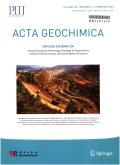Fresh insights into the onset of big mantle wedge beneath the North China Craton
Abstract
The onset of the big mantle wedge (BMW) structure beneath the North China Craton remains debated. Research on the genesis of Late Mesozoic granites associated with gold deposits in the Jiaodong Peninsula above the BMW could provide fresh insights into this question. The monzogranite from the Zhaoxian-Shaling gold district was intruded during 154–148 Ma. This I-type granite has high-K calc-alkaline and metaluminous characteristics. The monzogranite formed at medium temperatures (718–770 °C) and was generated in a thickened lower crust at depths within the stability field of garnet. The monzogranite's high zircon Ce4+/Ce3+ and EuN/EuN* values and low FeOT/MgO ratios, suggest that it formed in a high oxygen environment. Its variable εHf(t) values with TDM2 of 1.93–2.87 Ga imply that it originated from the melting of ancient crust basement, with contributions from mantle-derived materials. The granite's enrichment in LREEs and LILEs, and depletion in HREEs and HFSEs, along with its trace element tectonic discrimination diagrams and medium Sr/Y, indicate an adakite affinity in an active continental margin setting. The transition from S-type granites to I-type granites and finally to A-type granites observed in the eastern part of North China Craton suggests a shift in the tectonic environment from compression to extension. This change is also reflected in the transition from flat subduction to steep subduction. Therefore, the monzogranite was formed in a tectonic transition setting triggered by a change in the subduction angle of the Paleo-Pacific Ocean slab during the Late Jurassic. This event may have marked the initiation of the BMW above the North China Craton.

 求助内容:
求助内容: 应助结果提醒方式:
应助结果提醒方式:


